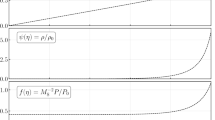Abstract
We present the mathematical deduction and properties of the mean traveltime curves for homogeneous elliptical anisotropic media. These curves generalize their isotropic counterparts which have been introduced in the past as a simple data quality analysis technique at the pre-inversion stage for 2D transmission experiments, allowing the inference of prior velocity models to gain stability at the tomographic inversion. Also, the anisotropy parameters (maximum velocity, anisotropic direction and ratio) are shown to affect the shape of these curves. The degree of asymmetry of the anisotropic mean traveltime curves (displacement of the mean time and standard deviation minima from the middle of the gathering line) is related to the direction of anisotropy which can then be visually estimated. Least squares’ fitting of the anisotropic theoretical models to their experimental counterparts is an effective method to estimate at the pre-inversion stage a macroscopic elliptical anisotropic velocity model, valid at the scale of the experiment, and able to match the experimental mean traveltime distribution.
Sensitivity analysis has shown that the mean curve is less prone to errors than the standard deviation curve. Parameter identification from the standard deviation curve becomes unstable for noise levels higher than 5%; data errors produce smearing of the value of the estimated anisotropy ratio and wrong directions of anisotropy biased towards zero degrees. Also, identification from the mean traveltime curve becomes stable when the maximum velocity is well constrained. Finally, this methodology is illustrated with the application to the Grimsel data set. Performing MTC analysis is always recommended since it does not need high numerical requirements, and as shown in the sensibility analysis section, errors in data can be misinterpreted as geological anisotropies.
Similar content being viewed by others
References
Byun BS, Corrigan D (1990) Seismic traveltime inversion for transverse isotropy. Geophysics 55(2):192–200
Carlisle A, Dozier G (2001) An off-the-shelf PSO. In: Proceedings of the workshop on particle swarm optimization, Indianapolis, USA
Carrion P, Costa J, Ferrer-Pinheiro JE, Schoenberg M (1992) Cross-borehole tomography in anisotropic media. Short note. Geophysics 57(9):1194–1198
Elapavuluri PK (2003) Estimation of Thomsen’s anisotropic parameters from geophysical measurements using equivalent offset gathers and shifted-hyperbola NMO equation. MSc thesis, University of Calgary
Fernández Martínez JL, García Gonzalo E (2008) The generalized PSO: a new door to PSO evolution. J Artif Evol Appl. DOI:10.1155/2008/861275
Fernández Martínez JL, Fernández Álvarez JP, Pedruelo González LM (2006) Mean traveltime curves analysis: a method to improve understanding of data behaviour in 2-D transmission tomography at the pre-inversion stage. Math Geol 38(3):343–374
Fernández Martínez JL, Fernández Alvarez JP, Pedruelo González LM (2008) MTCLAB: a MATLAB®-based program for traveltime quality analysis and preinversion velocity tuning in 2-D transmission tomography. Comput Geosci. doi:10.1016/j.cageo.2007.03.008
Hansen C (1998) Rank deficient and discrete ill-posed problems: numerical aspects of linear inversion. SIAM, monographs of mathematical modelling and computation. SIAM, Philadelphia
Kennedy J, Eberhart RC (1995) Particle swarm optimization. In: Proceedings of the 1995 IEEE international joint conference on neural networks. IEEE Service Center, Piscataway, NJ, pp 1942–1948
Pratt RG, Chapman CH (1992) Traveltime tomography in anisotropic media. Theory Geophys J Int 109:1–19
Scales JA, Gersztenkorn A (1988) Robust methods in inverse theory. Inverse Probl 4:1071–1091
Schoenberg M, Sayers CM (1995) Seismic anisotropy of fracture rock. Geophysics 60(1):204–211
Tarantola A (2005) Inverse problem theory and methods for model parameter estimation. SIAM, Philadelphia
Thomsen L (1986) Weak elastic anisotropy. Geophysics 51:1954–1966
Upadhyay SK (2004) Seismic reflection processing. With special reference to anisotropy. Springer, Berlin
Van der Baan M, Kendall JM (2002) Estimating anisotropy parameters and traveltimes in the τ-p domain. Geophysics 67(4):1076–1086
Vernik L, Liu X (1997) Velocity anisotropy in shales: a petrophysical study. Geophysics 62(2):521–532
Xiao C, Bancroft JC, Brown RJ (2004) Estimation of anisotropy parameters in VTI media. Crewes project, University of Calgary
Wang Z (2002) Seismic anisotropy in sedimentary rocks. Laboratory data. Geophysics 67(5):1423–1440
Watanabe T, Hirai T, Sassa K (1996) Seismic traveltime tomography in anisotropic heterogeneous media. J Appl Geophys 35:133–143
Williamson PR, Sams MS, Worthington MH (1993) Crosshole imaging in anisotropic media. Lead Edge 12:19–23
Author information
Authors and Affiliations
Corresponding author
Additional information
J.L. Fernández Martínez is a visiting professor at UC Berkeley, Department of Civil and Environmental Eng., CA 94720-1710.
Rights and permissions
About this article
Cite this article
Fernández Martínez, J.L., Pedruelo González, L.M. Anisotropic Mean Traveltime Curves: A Method to Estimate Anisotropic Parameters from 2D Transmission Tomographic Data. Math Geosci 41, 163–192 (2009). https://doi.org/10.1007/s11004-008-9202-4
Received:
Accepted:
Published:
Issue Date:
DOI: https://doi.org/10.1007/s11004-008-9202-4




